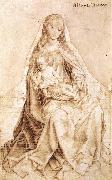Großhandels China Öl Gemälde & Rahmt Ein |
|||||||||||

|
|||||||||||
|
|
|
||||||||||||||
|
WEYDEN, Goossen van der
Flemish painter (b. ca. 1465, Bruxelles, d. after 1538, Antwerpen) |
||||||||||||||
|
|
||||||||||||||
|
||||||||||||||
|
|
||||||||||||||
| WEYDEN, Goossen van der
Flemish painter (b. ca. 1465, Bruxelles, d. after 1538, Antwerpen) 1450-55 Metalpoint on white paper mounted on pink-coloured sheet, 216 x 133 mm Museum Boijmans Van Beuningen, Rotterdam The Virgin is seated between two columns which stand on a low wall, probably intended as walled loggia or hall with behind it in the middle an opening flanked by columns, as Van der Weyden painted in his St Luke painting the Virgin. The situation is strongly reminiscent of the configuration of nearly all of Memling's enthroned Virgins, so that one wonders whether this drawing might not reflect the ultimate prototype of Memling's formula. This conclusion is further enhanced by the position of the Child who, seated on one of his mother's hands and gently restrained with the other, is turning sideways in an attitude of blessing. This is also Memling's basic motif. The high finish of the modelling and draperies and the summary treatment of the architectural setting seem to suggest a copy drawn by the master himself of the main figure of one of his own paintings. The drawing would thus have been intended as a studio model which later ended up in Bruges workshops. It is impossible, however, to `reconstruct' Van der Weyden's lost painting from the derived versions, which are far too divergent; in some the Mother and Child are worshipped by one or two founders, in others they are surrounded by holy women or flanked by angels. The inscription 'Alberto Durer' at top left is a later addition from the 19th century |
||||||||||||||
|
Related Paintings to WEYDEN, Goossen van der :. |
||||||||||||||
|
|
||||||||||||||
|
|
||||||||||||||
|
KONTAKTIEREN Sie UNS |







